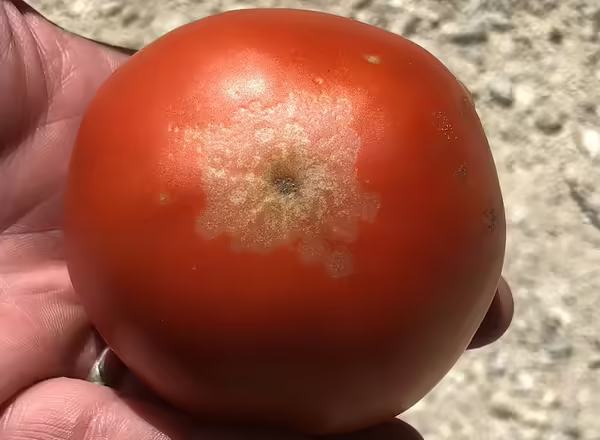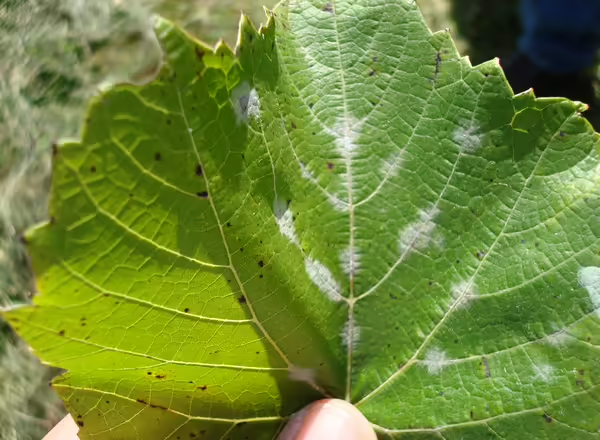
High temperatures and very high humidity are the current conditions in the St Louis Metro East. The entire region has received rain recently, just not all at the same time or the same amount. In general, soil conditions worsen as you move south, but are improved from the last reporting.
Harvest in ongoing in peaches. Early varieties, like Desiree, PF5 and Glenglo, are harvested and the Bounty window has just started. Blackberries have been in harvest for a few weeks, bringing us to the beginning of ‘Chester’ harvest. 'Sweet Maia’ apple is still a few weeks out. Main season sweet corn is in harvest, as well as field tomatoes.

Blossom end rot has been more problematic this season in tomato, especially where foliar calcium has not been supplemented. It’s been so dry, the normal secondary fungus that causes the normal blackening of the fruit has been lacking, leaving just the water soaking.
For our soils, calcium deficiency is usually not the main culprit, but rather the limited ability of the plant to take up enough soil calcium quickly enough to meet growth needs, especially now when plants have a high growth rate. Calcium on the best day is not readily moved within a plant, so anything that interferes with uptake only exacerbates the issue.
Rapid growth also demands more calcium, and when needs aren’t met, cell walls start breaking down at the furthest point of demand…the blossom end of fruit. Dry soil, wet soils, and fluctuations between the two interfere with calcium uptake. Any methods to normalize or maintain soil moisture, like irrigation, can help reduce blossom end rot. Foliar applied calcium is another option. Although leaves are not as efficient at taking up nutrients compared to roots, foliar application it is a way to get some calcium closer to the point of need.
There are several products on the market, usually a calcium chloride derivative or a chelated calcium form. The chelated calcium form has the benefit of greatly reduced foliar burn in dry conditions and less wear on equipment but is it usually more expensive. Calcium chloride is usually cheaper but can cause foliar burn if a wash off event (rain or overhead irrigation) doesn’t occur between applications. For known problematic cultivars, start sprays on a weekly basis when fruit becomes visible. At the latest, start foliar sprays at the first sign of water soaking on the blossom end.
High temperatures have slowed tomato ripening and bunched up harvest windows for other crops like sweet corn and peaches. The optimum temperature for ripening tomatoes is 70◦ to 75◦F and when temperatures exceed 85◦ to 90◦F, the ripening process slows significantly or even stops. Sunburn is showing up on several crops like tomatoes, peppers, blackberries, peaches, and apples. Transpiration is a process plants use to “cool” themselves, but dry soils combined with high relative humidity can greatly reduce the driving force behind transpiration, resulting in heat injuries not only from increased temperatures but also the direct effect of the sun’s rays.
Remember your disease triangle: all you need is the pathogen, a susceptible host, and favorable environmental conditions. The only leg of the stool we have been missing is the rain…we almost always have the susceptible host and the pathogen. Lack of rain for the most part has reduced the need for fungicide sprays, but remember the pathogens are still out there ready and waiting for sufficient leaf wetness to occur. Protectant (contact) type fungicides need to be applied ahead of an infection event (rain, overhead irrigation) to prevent disease spread. If rain is in the forecast, be prepared to treat. Systemics don’t have the wash-off risk, but they also have the added benefits of some kickback (curative), usually up to a couple days.
In terms of wash-off, assume any surface residue (contact pesticide) remaining is completely washed off after a 2” rain event, regardless of when you applied it. Reapply immediately. After a 1” rain event, assume your remaining residue has been reduced by half. So, if you are on day 6 of a 12-day interval, instead of spraying in 6 days, you need to spray in 3.
Powdery mildew has been bad across the board and several crops are at high risk from this disease, especially grapes and pumpkins/vine crops. Powdery mildew is favored by a lack of rainfall and high humidity, exactly what we have right now. In grapes, a powdery mildew infection can not only reduce leaf canopy but result in micro cracking of fruit. These micro cracks can lead to further infection by spoilage organisms. When conditions are conducive to powdery mildew, control needs to be a priority. With pumpkins and other vine crops, the entire leaf canopy can be destroyed by powdery mildew. On pumpkins, start scouting leaf petioles and the underside of leaves. It appears on the upper leaf surfaces last, so it’s not a good sign if you have missed your early control window. For powdery mildew, make sure you are using an effective fungicide. Like with rust diseases, not all fungicides are effective against powdery mildew.


Author: Elizabeth Wahle, commercial ag educator with specialty in fruits and vegetables